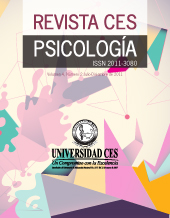Emotional intelligence, Empathy and Warmth as Protective Factors Against Physical Aggression in Adolescents
DOI:
https://doi.org/10.21615/cesp.5222Keywords:
prosocial behavior, emotional intelligence, empathy, warmth, physical aggression, aggressiveness, adolescentsAbstract
Adolescence is a stage in which psychological resources that influence the interactions with others are developed, some of which can represent protective factors against problems such as physical aggressiveness. The aim of this study was to analyze the predictive value of emotional intelligence, empathy, and warmth over physical aggression in adolescents. The sample included 2161 high school students of the Metropolitan Area of Guadalajara, Jalisco, Mexico (M=16.7 years, SD= .023). The participants answered the Emotional Quotient Inventory (EQi-YV), the Basic Empathy Scale, modified for adolescents (EBE), the Warmth Scale (EBT) and the scale of physical aggression from the Aggression Questionnaire. Statistical analysis included correlation test and a stepwise multiple lineal regression. The results indicated a negative correlation between all the study variables and physical aggression (p<.01). In the final predictive model, it was found that stress management, adaptability, kindness, consideration, affective empathy, and self-generated physical warmth are protective factors against physical aggression. Likewise, the intrapersonal competence, cognitive empathy and self-generated psychological warmth appeared as predictive variables for this type of aggression (R2 = .30). We conclude that social and emotional competences, oriented towards emotional regulation and attention to the other´s needs, are resources that influence the way an adolescent responds to conflict.
Downloads
References
Alquízar, L., & Pino, W. (2018). Caracterización de la violencia en adolescentes. Revista Cubana de Medicina Militar, 47(4), 1-14. http://www.revmedmilitar.sld.cu/index.php/mil/article/view/159/249
Álvarez Mendoza, K. (2017). Acoso escolar y habilidades sociales en adolescentes de dos instituciones educativas estatales de Ate. Avances En Psicología, 24(2), 205-215. https://doi.org/10.33539/avpsicol.2016.v24n2.155
Bar-On, R. & Parker, J. (2000). The Bar-On Emotional Quotient Inventory: Youth Version (EQ-i: YV). Technical Manual. Toronto, Canada: Multi-Health Systems, Inc.
Bar-On, R. (2006). The Bar-On model of emotional-social intelligence (ESI). Psychothema, 18(supl), 13-25. Recuperado de http://www.redalyc.org/articulo.oa?id=72709503
Buss, A. H., & Perry, M. (1992). The Aggression Questionnaire. Journal of Personality and Social Psychology, 63(3), 452–459. https://doi.org/10.1037/0022-3514.63.3.452
Caballero, S., Contini, N., Lacunza, A., Mejail, S., & Coronel, P. (2018). Habilidades sociales, comportamiento agresivo y contexto socioeconómico. Un estudio comparativo con adolescentes de Tucumán (Argentina). Cuadernos de la Facultad de Humanidades y Ciencias Sociales-Universidad Nacional de Jujuy, 53, 183-203. Recuperado de http://revista.fhycs.unju.edu.ar/revistacuadernos/index.php/cuadernos/article/view/261/414
Castillo, G. R., Cabello, R., Herrero, M., Rodríguez, C. R., & Fernández, B. P. (2018). A Three‐Year Emotional Intelligence Intervention to Reduce Adolescent Aggression: The Mediating Role of Unpleasant Affectivity. Journal of Research on Adolescence (Wiley-Blackwell), 28(1), 186–198. https://doi.org/10.1111/jora.12325
Contini, N. (2015). Agresividad y habilidades sociales en la adolescencia. Una aproximación conceptual. Psicodebate, 15(2), 31-54. Recuperado de https://dspace.palermo.edu/ojs/index.php/psicodebate/article/download/533/pdf_12
Carrascosa, L., Cava, M., & Buelga, S. (2016). Ajuste psicosocial en adolescentes víctimas frecuentes y víctimas ocasionales de violencia de pareja. Terapia psicológica, 34(2), 93-102. https://doi.org/10.4067/S0718-48082016000200002
Corrales, A., Quijano, N., León, N., & Góngora, E. (2017). Empatía, comunicación asertiva y seguimiento de normas. Un programa para desarrollar habilidades para la vida. Enseñanza e Investigación en Psicología, 22(1), 58-65. Recuperado de https://www.redalyc.org/pdf/292/29251161005.pdf
Eisenberg, N. (2000). Emotion, regulation and moral development. Annual Review of Psychology, 51, 665-697. https://doi.org/10.1146/annurev.psych.51.1.665
Escobar, M., & Reinoza, M. (2017). Acoso Escolar: Un análisis contextual en escuelas secundarias venezolanas desde el reporte de víctimas y perpetradores. REXE. Revista de Estudios y Experiencias en Educación, 16(31), 15-28, https://doi.org/10.21703/rexe.20173115281
Estévez, C., Carrillo, A., & Gómez, M. (2018). Inteligencia emocional y bullying en escolares de primaria. International Journal of Developmental and Educational Psychology INFAD, 1(1), 227-238. Recuperado de http://www.redalyc.org/jatsRepo/3498/349855553025/349855553025.pdf
Estévez, E., Jiménez, T. I., & Segura, L. (2019). Emotional intelligence and empathy in aggressors and victims of school violence. Journal of Educational Psychology, 111(3), 488–496. https://doi.org/10.1037/edu0000292
Garaigordobil, M., & Maganto, C. (2011). Empatía y resolución de conflictos durante la infancia y la adolescencia. Revista Latinoamericana de Psicología, 43(2), 225-266. Recuperado de http://www.redalyc.org/pdf/805/80521287004.pdf
Garaigordobil, M., Machimbarrena, J., & Maganto, C. (2016). Adaptación española de un instrumento para evaluar la resolución de conflictos (Conflictalk): Datos psicométricos de fiabilidad y validez. Revista de Psicología Clínica con Niños y Adolescentes, 3(2), 59-67. Recuperado de http://www.redalyc.org/articulo.oa?id=477152554007
Holley, S., Ewing, S., Stiver, J., & Bloch, L. (2017). The Relationship Between Emotion Regulation, Executive Functioning, and Aggressive Behaviors. Journal of Interpersonal Violence, 32(11), 1692–1707. https://doi.org/10.1177/0886260515592619
Hsieh, I.-J. & Chen, Y. (2017). Determinants of aggressive behavior: Interactive effects of emotional regulation and inhibitory control. PLoSONE, 12(4), 1–9. https://doi.org/10.1371/journal.pone.0175651
Inglés, C., Torregrosa, M., García, J., Martínez, M., Estévez, E., & Delgado, B. (2014). Conducta agresiva e inteligencia emocional en la adolescencia. European Journal of Education and Psychology, 7(1), 29-41. https://doi.org/10.30552/ejep.v7i1.97
Jaffe, A., Simonet, D., Tett, R., Swopes, R., & Davis, J. (2015). Multidimensional Trait Emotional Intelligence and Aggressive Tendencies in Male Offenders of Domestic Violence. Journal of Family Violence, 30(6), 769–781. https://doi.org/10.1007/s10896-015-9729-3
Jiménez-Camargo, L., Lochman, J., & Sellbom, M. (2017). Externalizing Behavior in at-Risk Preadolescents: Relationships among Effortful Control, Affective Experiences, and Autonomic Psychophysiology. Journal of Psychopathology & Behavioral Assessment, 39(3), 383–395. https://doi.org/10.1007/s10862-017-9604-z
Jolliffe, D., & Farrington, D. (2006). Development and validation of the Basic Empathy Scale. Journal of Adolescence, 29, 589-611. https://doi.org/10.1016/j.adolescence.2005.08.010
Klimecki, O., Vuilleumier, P., & Sander, D. (2016). The Impact of Emotions and Empathy-Related Traits on Punishment Behavior: Introduction and Validation of the Inequality Game. PLoSONE, 11(3): e0151028. https://doi.org/10.1371/journal.pone.0151028
Lacunza, A. B., Caballero, S., Contini, E., & Llugdar, A. (2016). Estudio psicométrico del Cuestionario de Conducta Antisocial (CC-A) en adolescentes tempranos de Tucumán (Argentina). Revista Psicología desde el Caribe, 33(3), 250-264. https://doi.org/10.14482/psdc.33.3.9488
López, M., Arán, V., & Richaud, M. (2014). Empatía: desde la percepción automática hasta los procesos controlados. Avances en Psicología Latinoamericana, 32(1), pp. 37-51. https://doi.org/10.12804/apl32.1.2014.03
López-Zafra, E., Pulido, M., & Berrios, P. (2014). EQ-i Versión corta (EQI-C), Adaptación y validación al español del EQ-i en universitarios. Boletín de Psicología, 110, 21-36. Recuperado de https://www.uv.es/seoane/boletin/previos/N110-2.pdf
Lugones, M., & Ramírez-Bermúdez, M. (2017). Bullying: aspectos históricos, culturales y sus consecuencias para la salud. Revista Cubana de Medicina General Integral, 33(1), 1-10. Recuperado de https://pdfs.semanticscholar.org/e95a/05e68238c244479db3e3d1566d4f9b291a0f.pdf?_ga=2.116066374.1907126115.1592018955-484996855.1592018955
Luna, A., & de Gante, A. (2017). Empatía y gestión de conflictos en estudiantes de secundaria y bachillerato. Revista de Educación y Desarrollo, 40(1), 27-37. Recuperado de http://www.cucs.udg.mx/revistas/edu_desarrollo/anteriores/40/40_DeGante.pdf
Madrid-Valero, J., Ordoñana, J., Klump, K., & Burt, S. (2019). Children Sleep and Antisocial Behavior: Differential Association of Sleep with Aggression and Rule-Breaking. Journal of Abnormal Child Psychology, 47(5), 791–799. https://doi.org/10.1007/s10802-018-0480-0
Martínez, F., & González, J. (2017). Autoconcepto, práctica de actividad física y respuesta social en adolescentes. Relaciones con el rendimiento académico. Revista Iberoamericana de Educación, 73(1), 87-108. https://doi.org/10.35362/rie731127
Mejail, S., & Contini, E. (2016). Agresividad y habilidades sociales. Un estudio preliminar con adolescentes de escuelas públicas. Cuadernos Universitarios, 9(1), 85-100. Recuperado de https://www.ucasal.edu.ar/htm/cuadernos-universitarios/cuaderno2017/cuaderno-9/Psicologia-1-Agresividad-Mejail-Contini.pdf
Merino, C., & Grimaldo, M. (2015). Validación Estructural de la Escala Básica de Empatía (Basic EmpathyScale) Modificada en Adolescentes: un Estudio Preliminar. Revista Colombiana de Psicología, 24(2), 261-270. https://doi.org/10.15446/rcp.v24n2.42514
Mestre, V., Samper, P., Tur-Porcar, A. M., Richaud de Minzi, M. C., & Mesurado, B. (2012). Emociones, estilos de afrontamiento y agresividad en la adolescencia. Universitas Psychologica, 11(4), 1263-1275. Recuperado de http://www.scielo.org.co/pdf/rups/v11n4/v11n4a20.pdf
Morales, F., Codorniu, M., & Vigil, A. (2005). Características psicométricas de las versiones reducidas del cuestionario de agresividad de Buss y Perry. Psicothema, 17(1), 96-100. Recuperado de http://www.psicothema.com/pdf/3070.pdf
Oros, L., & Fontana, A. (2015). Niños socialmente hábiles: ¿cuánto influyen la empatía y las emociones positivas? Interdisciplinaria, 32(1), 109-125. Recuperado de http://www.redalyc.org/articulo.oa?id=18041090006
Park, S., Chiu, W., & Won, D. (2017). Effects of physical education, extracurricular sports activities, and leisure satisfaction on adolescent aggressive behavior: A latent growth modeling approach. PLoSONE, 12(4), e0174674. https://doi.org/10.1371/journal.pone.0174674
Pérez-Fuentes, M., Molero, M., Barragán, A., & Gázquez, J. J. (2019). Family Functioning, Emotional Intelligence, and Values: Analysis of the Relationship with Aggressive Behavior in Adolescents. International Journal of Environmental Research & Public Health, 16(3), 478. https://doi.org/10.3390/ijerph16030478
Reglamento de la Ley General de Salud en Materia de Investigación para la Salud (Ley). Art. 17. 2 de abril de 2014 (México).
Richaud, M., & Mesurado, B. (2016). Las emociones positivas y la empatía como promotores de las conductas prosociales e inhibidores de las conductas agresivas. Acción Psicológica, 13(2), 31-42. https://doi.org/10.5944/ap.13.2.17808
Ruvalcaba, N., Alfaro, L., Orozco, G., & Rayón, R. (2018). Construcción y validación de la Escala de Buen Trato en adultos mexicanos. Revista de Educación y Desarrollo, 46(3), 7-14. Recuperado de http://www.cucs.udg.mx/revistas/edu_desarrollo/anteriores/46/46_Ruvalcaba.pdf
Ruvalcaba, N., & Alva, M. (2013). Rescatando historias de buen trato en la infancia: entre las redes de apoyo social y las emociones positivas. En N. A. Ruvalcaba, L.E. Oliveros, M. G. Covarrubias, R. Flores & J. J. Gutiérrez (Eds). Aportes interdisciplinarios en el ejercicio profesional de la salud mental, VOL. II., (pp. 25-38). Guadalajara, México: Universidad de Guadalajara
Ruvalcaba, N., Gallegos, J., & Fuerte, J. (2017). Competencias socioemocionales como predictoras de conductas prosociales y clima escolar positivo en adolescentes. Revista Interuniversitaria de Formación del Profesorado, 88(31.1), 77-90. Recuperado de https://www.redalyc.org/jatsRepo/274/27450136012/html/index.html
Ruvalcaba, N., Gallegos, J., Lorenzo, M., & Borges, A. (2014). Propiedades psicométricas del inventario de competencias socioemocionales para adolescentes (EQi-YV) en población mexicana. Evaluar, 14(1), 1-14. https://doi.org/10.35670/1667-4545.v14.n1.8409
Ruvalcaba, N., Salazar, E., & Gallegos, J. (2012). Competencias socioemocionales y variables sociodemográficas asociadas a conductas disociales en adolescentes mexicanos. Revista CES Psicología, 5(1), 1-10. Recuperado de http://revistas.ces.edu.co/index.php/psicologia/article/view/2070/1452
Sanchez-Ruiz, M., & Baaklini, A. (2018). Individual and social correlates of aggressive behavior in Lebanese undergraduates: The role of trait emotional intelligence. J Soc Psychol., 158(3), 350-360. https://doi.org/10.1080/00224545.2017.1353476
Sanz, F. (2016). El buentrato: como proyecto de vida. Barcelona: Kairos
Schlomer, G., Cleveland, H., Vandenbergh, D., Feinberg, M., Neiderhiser, J., Greenberg, … Redmond, C. (2015). Developmental Differences in Early Adolescent Aggression: A Gene × Environment × Intervention Analysis. Journal of Youth & Adolescence, 44(3), 581–597. https://doi.org/10.1007/s10964-014-0198-4
Schmits, E., & Glowacz, F. (2019). Delinquency and drug use among adolescents and emerging adults: The role of aggression, impulsivity, empathy, and cognitive distortions. Journal of Substance Use, 24(2), 162–169. https://doi.org/10.1080/14659891.2018.1531945
Sullivan, T. N., Helms, S. W., Kliewer, W., & Goodman, K. L. (2010). Associations between sadness and anger regulation coping, emotional expression, and physical and relational aggression among urban adolescents. Social Development, 19(1), 30–51. https://doi.org/10.1111/j.1467-9507.2008.00531.x
Tur-Porcar, A., Llorca, A., Malonda, E., Samper, P., & Mestre, M. (2016). Empatía en la adolescencia. Relaciones con razonamiento moral prosocial, conducta prosocial y agresividad. Acción Psicológica, 13(2), 3-14. https://doi.org/10.5944/ap.13.2.17802
Ugarriza, N., & Pajares, L. (2005). La evaluación de la inteligencia emocional a través del inventario de BarOn ICE: NA, en una muestra de niños y adolescentes. Persona, 8, 11-58. Recuperado de https://www.redalyc.org/pdf/1471/147112816001.pdf
Vásquez, F. (2012). Buen trato. Su relación con la inteligencia emocional y la convivencia escolar. Revista Educación y Humanismo, 14(23), 37-46. Recuperado de http://publicaciones.unisimonbolivar.edu.co/rdigital/ojs/index.php/educacion/article/view/697/969
Zahedi, H., Kelishadi, R., Heshmat, R., Motlagh, M., Ranjbar, S., Ardalan, G. ..., Qorbani, M. (2014). Association of Junk Food Consumption with Mental Health in a National Sample of Iranian Children and Adolescents: the CASPIAN-IV Study. Nutrition, 30(11-12), 1391-7. https://doi.org/10.1016/j.nut.2014.04.014
Downloads
Published
How to Cite
Issue
Section
License
Copyright (c) 2021 CES Psicología

This work is licensed under a Creative Commons Attribution-NonCommercial-ShareAlike 4.0 International License.
Each manuscript is accompanied by a statement specifyingThat the materials are unpublished, that have not been previously published in printed formatElectronic and that they will not be presented to any other means before knowing the decision of the magazine. ThroughoutIn case, any previous publication, sea in printed or electronic form, must be made known to the editorial staffWriting The authors attach a signed statement stating that, and the manuscript is acceptedFor publication, the rights of reproduction are the exclusive property of the Journal CES Psychology.| Article metrics | |
|---|---|
| Abstract views | |
| Galley vies | |
| PDF Views | |
| HTML views | |
| Other views | |




